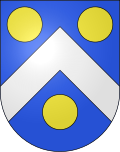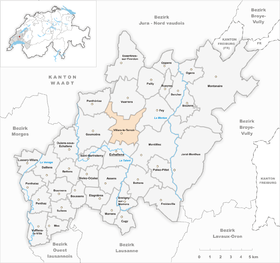Villars-le-Terroir
| Villars-le-Terroir | |
|---|---|
| State : |
|
| Canton : |
|
| District : | Gros-de-Vaud |
| BFS no. : | 5537 |
| Postal code : | 1040 |
| Coordinates : | 538 787 / 167708 |
| Height : | 647 m above sea level M. |
| Height range : | 588–668 m above sea level M. |
| Area : | 7.09 km² |
| Residents: | 1212 (December 31, 2018) |
| Population density : | 171 inhabitants per km² |
| Website: | www.villars-le-terroir.ch |
|
Villars-le-terroir |
|
| Location of the municipality | |
Villars-le-Terroir is a municipality in the Gros-de-Vaud district in the canton of Vaud in Switzerland .
geography
Villars-le-Terroir is 647 m above sea level. M. , 2 km north of Echallens and 15 km north of the canton capital Lausanne (as the crow flies). The scattered village extends on the plateau of the central Gros de Vaud , north of the lowlands of talent , in the Vaud Plateau .
The 7.1 km² municipal area covers a section of the gently undulating high plateau of the Gros de Vaud, the granary of the canton of Vaud. The main part of the area is occupied by a wide ridge between the valley lowlands of the Buron in the west, the Talent in the south and the Sauteru in the east. At 676 m above sea level M is the highest point of Villars-le-Terroir on the Montanare corridor . In the southeast, the municipality extends to the plain northeast of Echallens, which merges north into the valley of the Sauteru, which forms the eastern border. To the northeast, the municipality extends into the Charbonnière forest ( 646 m above sea level ). Villars-le-Terroir extends in a narrow tip to the northwest into the headwaters of the Buron. In 1997, 8% of the municipal area was accounted for by settlements, 14% for forests and woodlands and 78% for agriculture.
Villars-le-Terroir includes some new housing estates , the hamlets of Montandrey ( 648 m above sea level ) on a hill east of the Sauteru and Grand Buron ( 627 m above sea level ) in the valley of the Buron and several individual farms. The neighboring municipalities of Villars-le-Terroir are in the south Echallens , in the West Goumoëns , northwest Penthéréaz , in the north Vuarrens , northeast Fey , and in the southeast Montilliez .
population
With 1212 inhabitants (as of December 31, 2018) Villars-le-Terroir is one of the smaller municipalities in the canton of Vaud. 94.2% of the residents are French-speaking, 2.5% German-speaking and 0.8% Italian-speaking (as of 2000). The population of Villars-le-Terroir was 581 in 1900. After the population had decreased to 499 people by 1970, a significant increase in population was recorded again.
economy
Until the second half of the 20th century, Villars-le-Terroir was predominantly an agricultural village. Even today, arable farming , fruit growing and cattle breeding play an important role in the income structure of the population. There are other jobs in local small businesses and in the service sector. As the place has grown, a number of new businesses have set up, including a computer technology company and a transportation company. In the last few decades the village has developed into a residential community thanks to its attractive location. Many workers are therefore commuters who work mainly in Echallens and the greater Lausanne area .
traffic
The community has good transport connections. It is located on the main road 5 from Lausanne via Echallens to Yverdon . The La Sarraz motorway junction on the A1 (Lausanne-Yverdon) opened in 1981 is around 7 km from the town center. Villars-le-Terroir is connected to the public transport network by a postbus course that runs from Echallens to Yverdon.
history
The place name was first mentioned in 1438 under the name Villart le Terrioux , but a settlement existed much earlier. Later the names Villar le Terreux , Villars loz Terrour (1453), Villar le terricor (1536), Villar le Terriau (1668) and Villard le Terreau (1794) appeared. Villars comes from the Latin word villare (hamlet, village), while terroir is derived from the Latin territorium (area).
The lords of Colombier originally came from Villars-le-Terroir and belonged to the most important noble families in the canton of Vaud. In the Middle Ages , the village was part of Echallen's rule. After the Burgundian Wars , Villars-le-Terroir came to the Orbe-Echallens Bailiwick in 1476 , which was under the common rule of Bern and Friborg . After the collapse of the Ancien Régime , the village belonged to the canton of Léman from 1798 to 1803 during the Helvetic Republic, which then became part of the canton of Vaud when the mediation constitution came into force . In 1798 it was assigned to the Echallens district.
Attractions
A church in Villars-le-Terroir is mentioned as early as 1141. The current parish church was built between 1724 and 1733 and has been used by followers of both denominations ever since. The ship was redesigned in the neo-baroque style in 1906. In the old town center of Villars-le-Terroir, some characteristic farmhouses from the 17th to 19th centuries have been preserved.
Web links
- Official website of the municipality of Villars-le-Terroir (French)
- Aerial photography
- Marianne Stubenvoll: Villars-le-Terroir. In: Historical Lexicon of Switzerland .
Individual evidence
- ↑ Permanent and non-permanent resident population by year, canton, district, municipality, population type and gender (permanent resident population). In: bfs. admin.ch . Federal Statistical Office (FSO), August 31, 2019, accessed on December 22, 2019 .



